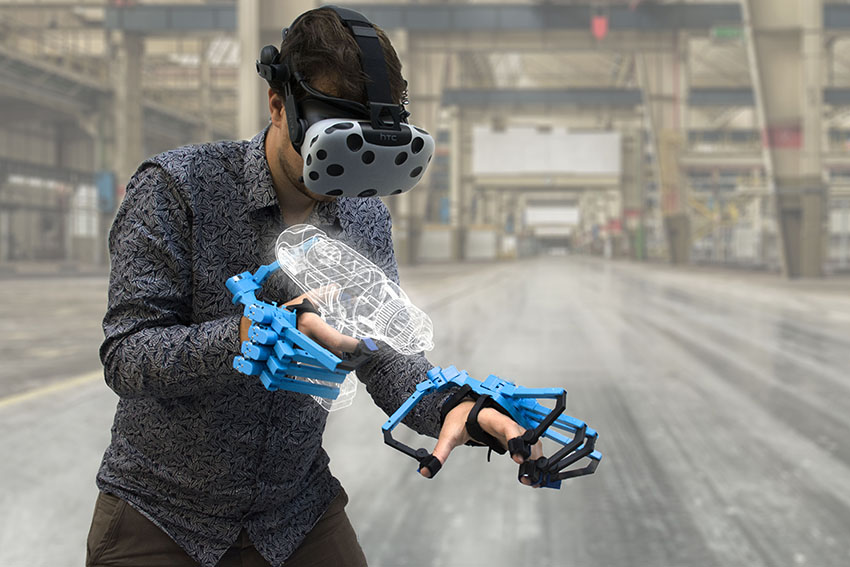SenseGlove allows you to physically feel virtual objects with your hands, by enabling touch in spatial computing. The most known forms of spatial computing are Virtual Reality (VR) and Robotics. We have developed a glove with force and haptic feedback that allows users to “feel” objects in VR. With the SenseGlove you can touch and hold virtual objects of different forms and density as if they were real: a glass capsule will break if you squeeze it too hard, a rubber pipe will feel a bit soft when empty and hard when full of water, a pneumatic drill will vibrate in your hands as you’re working with it.
Because users are able to feel in VR, they are forced to interact with VR objects the same way they do in real life. This makes the whole experience much more intuitive, realistic and also engages haptic memory, which is crucial for training purposes.
Easy Engineering: What are the main areas of activity of the company?
SenseGlove: Our hardware is used mostly by clients conducting R&D projects in VR. For example, we work with the University of Cambridge, Volkswagen, P&G, Ministry of Defense and many research institutions. Researchers use it for a variety of applications: from testing ergonomics and ways to improve assembly processes to simulating different health conditions.
As an example, Fraunhofer IEM used it to optimize their design for manufacturing processes. They created an Augmented Reality application in a joint research project with Hella Headlights. Assembly workers used SenseGlove with an AR headset and reported a much more realistic and intuitive experience compared to a simulation with traditional peripherals.
P&G used SenseGlove for nerve damage simulation to build empathy for patients. SenseGlove DK1 comes with easy-to-use software development APIs and also works well for people with limited coding experience.b
The SenseGlove is also used by clients in order to intuitively control a humanoid robotic gripper, this is what we call tele-robotics.

E.E: What’s the news about new products in 2020?
SenseGlove: In 2020 we launched a wireless kit that enabled users to connect the SenseGlove with a computer / VR headset without using a USB cable. It provides a higher freedom of movement which is crucial for research experiments and training purposes. We also launched the third iteration of our development kit, with stronger force-feedback and improved durability. We will be continuing our R&D and we launch two new products next year — the big news is coming soon!
E.E: What are the product characteristics?
SenseGlove: We have one product on the market, the SenseGlove Development Kit 1. It comes with a set of force and haptic feedback gloves, and an open-source software development kit. The SenseGlove DK1 gives each finger force-resistance of up to 40 Newton — which is like holding a cat on each finger (around 4 kilograms per finger). It also has 6 vibrotactile motors. These motors allow to simulate things like drill vibration, tactile feel of different types of textures as well as button feedback. The SenseGlove tracks 24 degrees of freedom, making it the most accurate hand-motion capturing wearable on the market.
E.E: What is the current situation on the VR market?
SenseGlove: The enterprise VR market is moving from the research stage and into the implementation phase. Speaking about haptics for spatial computing, this niche is roughly two years behind the trends currently in VR. Unlike VR, the haptic glove market is not that complex. There are only two force feedback VR glove options available. The rest are either in the development phase or offer vibro tactile experience only, without force-feedback. This is changing already: this domain is in full development with larger R&D budgets becoming available from early adopter enterprises.
E.E: What can you tell us about market trends?
SenseGlove: Haptics is becoming one of the hottest topics in the research domain of spatial computing. Having gloves for VR is getting as necessary as having a mouse was for a computer. Also, there is an increased research interest in tele-robotics. Companies are starting to realise that haptic VR training can be even more effective than real life training for just a fraction of the price. Also, the increasing availability of 5G technology allows companies to fully research the potential of remote-controlled robots. Proof-of-concept prototypes for such use cases as maintenance of high-voltage cables with tele-robotic solutions have already been shown to be viable.

E.E: What are the most innovative products marketed?
SenseGlove: Of course, SenseGlove Development Kit 1 is our most innovative product. Our patented force-feedback mechanism is lightweight and low on energy usage — and it doesn’t use gears. That is what makes SenseGlove the best yet affordable wireless force-feedback glove on the market.
E.E: What are your estimates for 2020?
SenseGlove: With Corona more companies got to learn about VR and implement it in some way: mostly for remote training and communication purposes. We expect these companies to dive deeper into the VR haptics industry, as more and more research becomes available now. Based on our experience, there is an increased interest from research institutions for tele-robotics and haptics in VR. Robotics and haptic technology in VR are considered promising for the fact that they enable companies to become more independent by reducing the need for physical presence. However, 2020 has taught us not to rely on predictions too much.

